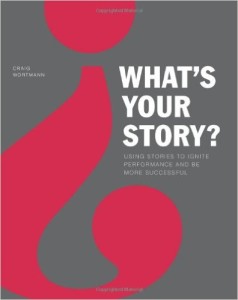 Every once in a while you meet someone and you think “Why haven’t we met earlier!?” Craig and I were actually introduced by a mutual friend and we share a similar outlook on how to be successful in business. And he knows his stuff – he’s a professor at the University of Chicago (while not quite at the level of my alma mater Northwestern, it’s still a pretty good school…). In fact, I knew that I would like his book right away because he used the term Luddite in the opening chapter of What’s Your Story?. I thought I was the only person geeky enough to put that in a business book.
Every once in a while you meet someone and you think “Why haven’t we met earlier!?” Craig and I were actually introduced by a mutual friend and we share a similar outlook on how to be successful in business. And he knows his stuff – he’s a professor at the University of Chicago (while not quite at the level of my alma mater Northwestern, it’s still a pretty good school…). In fact, I knew that I would like his book right away because he used the term Luddite in the opening chapter of What’s Your Story?. I thought I was the only person geeky enough to put that in a business book.
Big Thought
Stories are a powerful leadership tool that have more and more relevance as we are increasingly bombarded by massive amounts of information with less and less context to understand and digest it.
Ideas, Implications, and Questions
- Craig uses the concept of “bits and bullets” when referring to the brief, fast-paced communication in the modern business world. It’s the information that we get (and all to often send out) in emails, texts, powerpoints, and hurried voicemails. It’s hard to process this information meaningfully, and usually we don’t fully digest it or we spend time sidetracked by irrelevant or unimportant minutiae. As he writes, “Because we don’t have to spend time thinking through our communication, we don’t (9).
- I think there’s an important idea that Craig touches on that applies to all communication, not just leadership communication: “One of the reasons that leaders often fail to communicate even “simple” information is that it’s not simple. They have had time to think it through, socialize it, and move forward. But no one else has…”. (24) You can see this happening in your personal relationships. Think about the last time you considered a life decision in depth and then told your significant other about it in a few sentences. Then you sat there and wondered why they freaked out. You have to give people time to understand and develop the same context that you have. Stories are a way to do that.
- Here’s Craig’s list about why stories work (and I’m totally on-board):
- Stories create presence.
- Stories aren’t bullet points.
- Stories build strong relationships.
- Stories illustrate success and failure.
- Stories allows for reflection.
- Stories are an antidote.
- Stories show the how and why as well as the what.
- Stories show multiple perspectives.
- Stories help us unlearn.
- Stories spread.
- There are two big challenges with using stories to help communicate. One is having the right story for the right situation. Craig talks about three tools in What’s Your Story?: the Win Book, the Story Matrix, and the Story Coach. I think they are all useful conceptually, but I can see how they would be hard to incorporate into your daily work life if you don’t have a habit already developed. A simple workaround: be mindful of the value of stories and always be on the lookout for more.
- The other challenge is that stories aren’t told or heard in a vacuum. I think that stories only work if they are told authentically and if they land on fertile ground! This is touched on when soft skills are covered in the book, but I think that it’s important to look in the mirror to make sure that your intent and the stories that you tell are in alignment. Also, if you are going to use stories to “lead, sell, and motivate”, be sure that the culture of your organization is receptive to story telling.
Should you read this book? Who should read this book?
Stories are how humans communicate. Story-telling is not a business skill, it’s a life skill. Too often, professionals think the path to influence and authority is lined with PowerPoint slides and spreadsheets. But I think that the leaders of the future are going to the ones that can take the information overload and help their teams see the meaning behind all of the information. Craig has outlined steps to making story-telling a powerful tool for anyone. People who will get a lot out of this book:
- Entrepreneurs and small business owners who are building small, but dynamic, teams.
- Managers and executives in large companies who have to work through other people.
- Leaders in any type of organization who have to paint a vision and create buy-in from their people.
